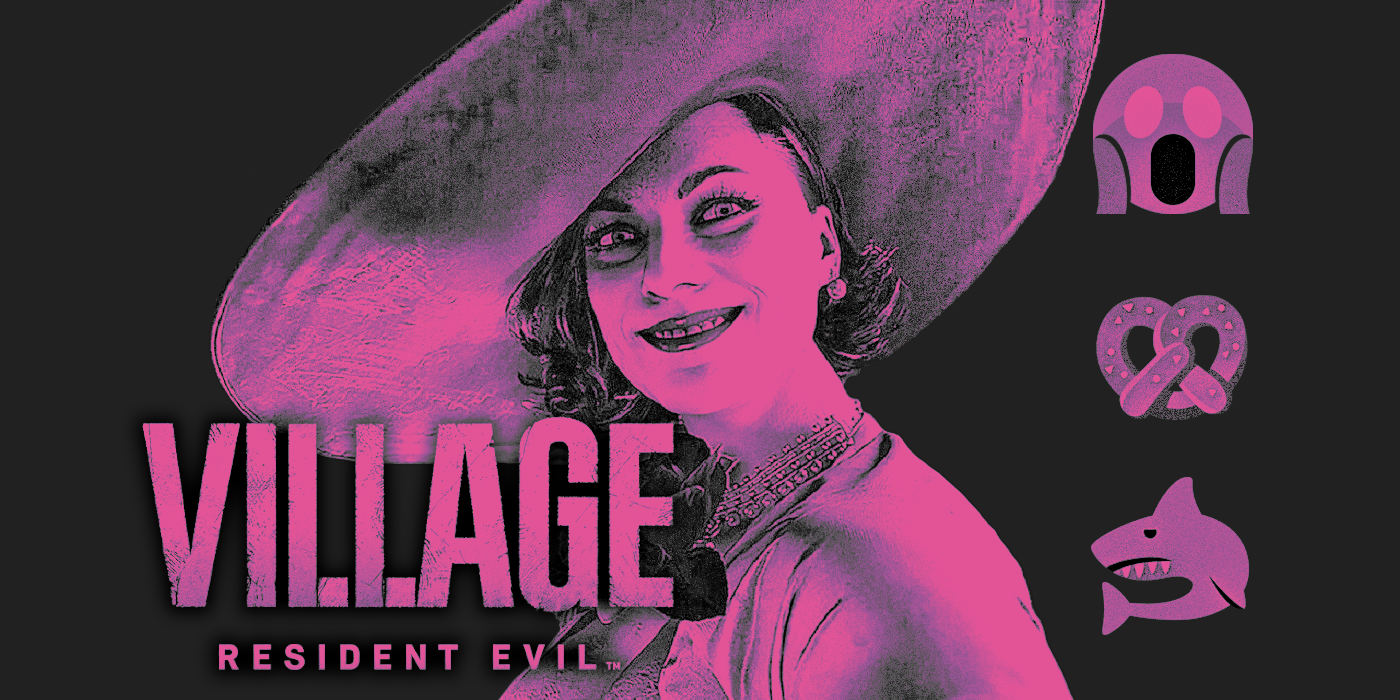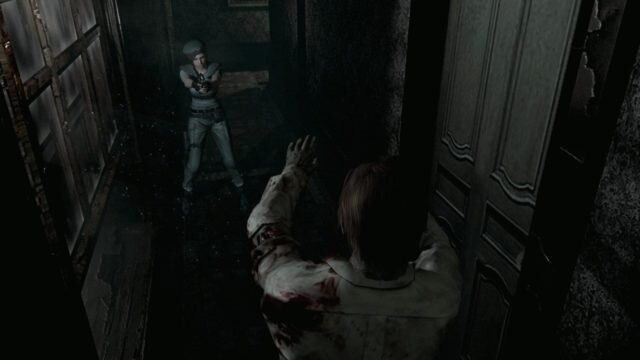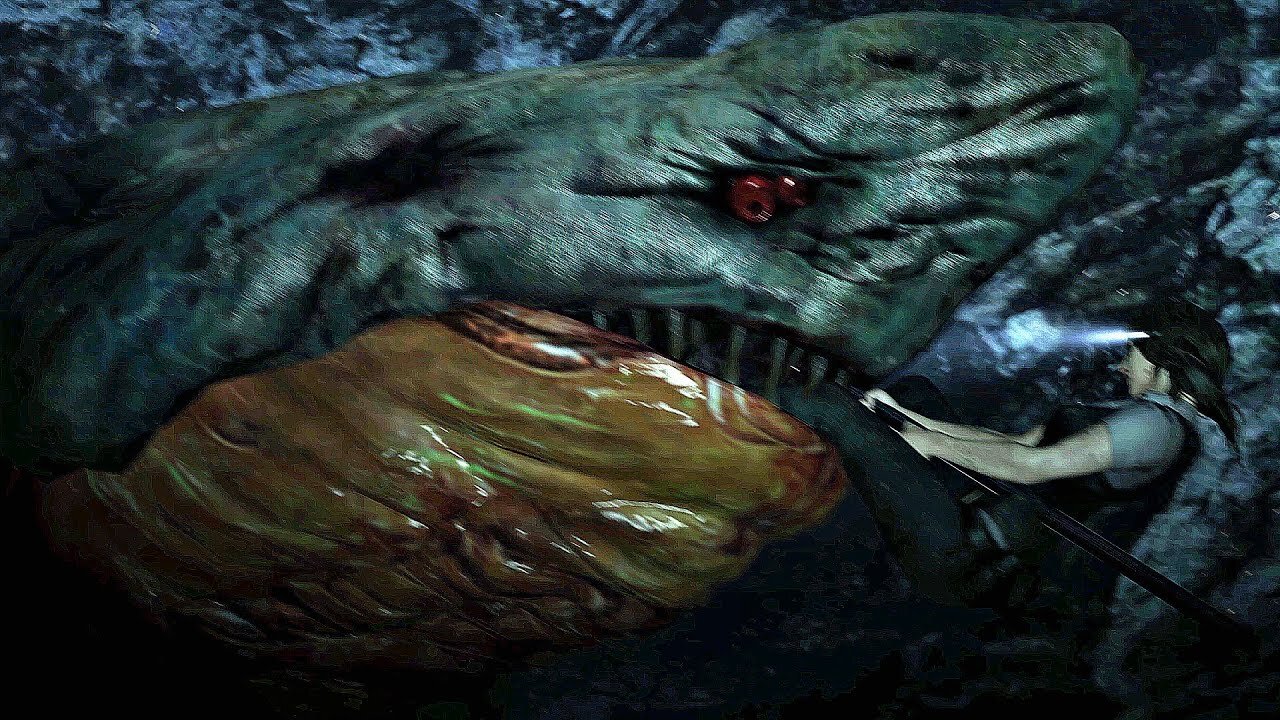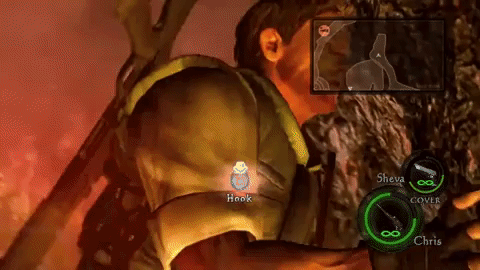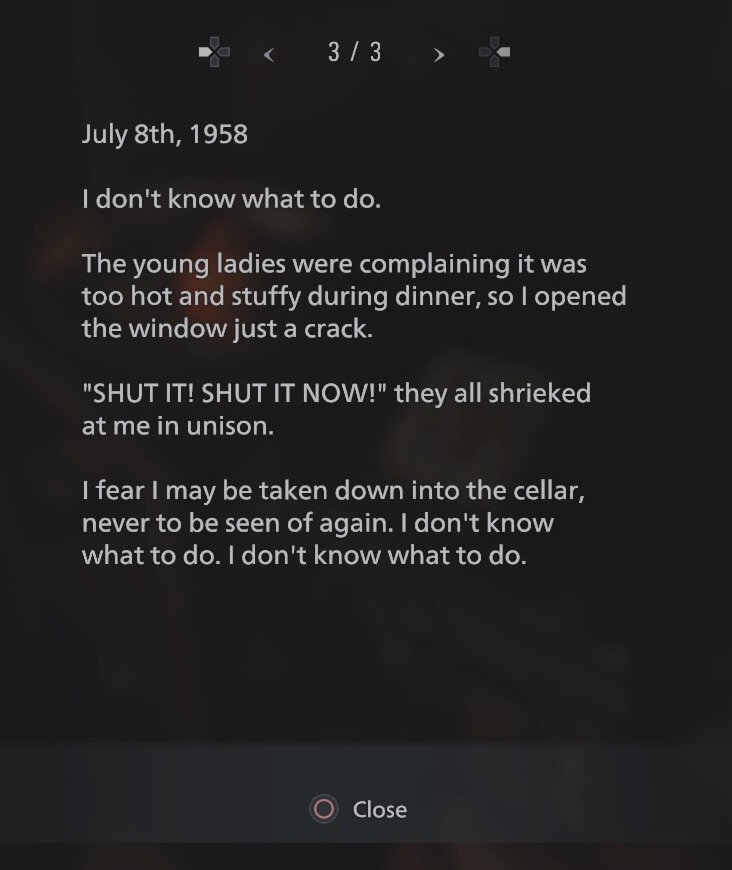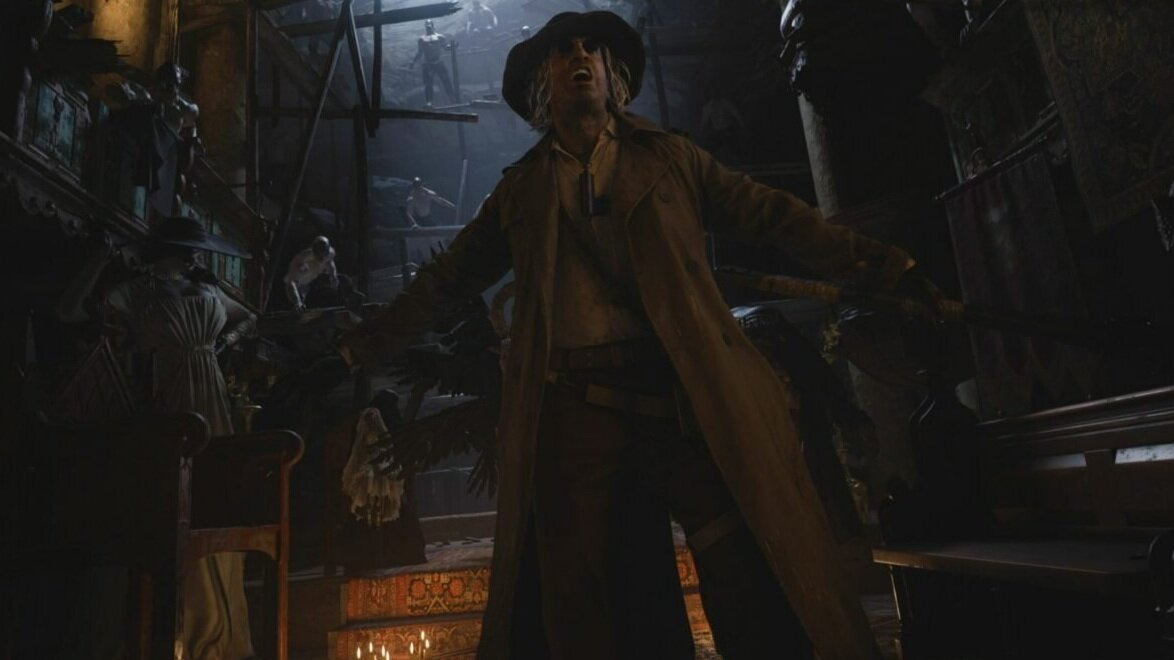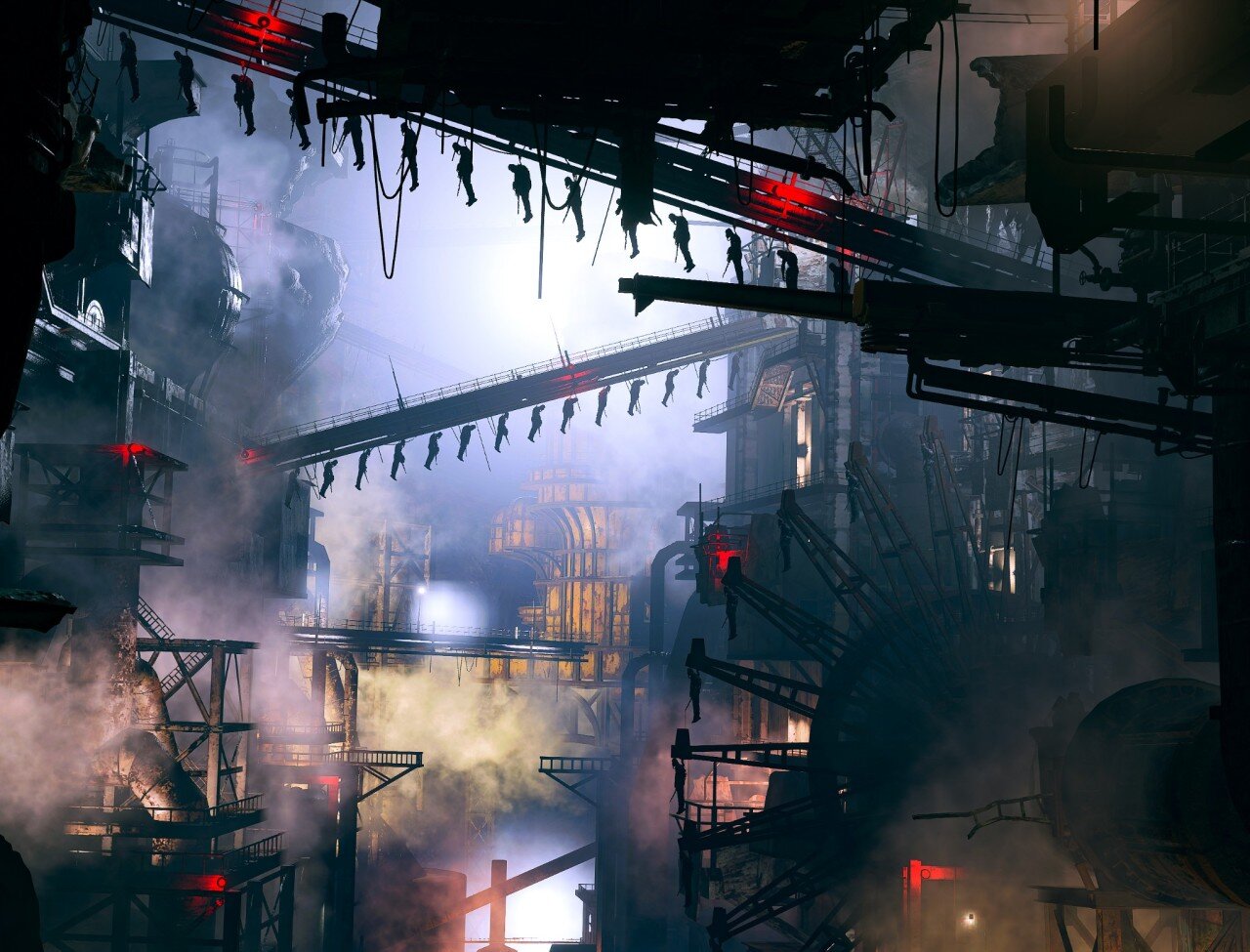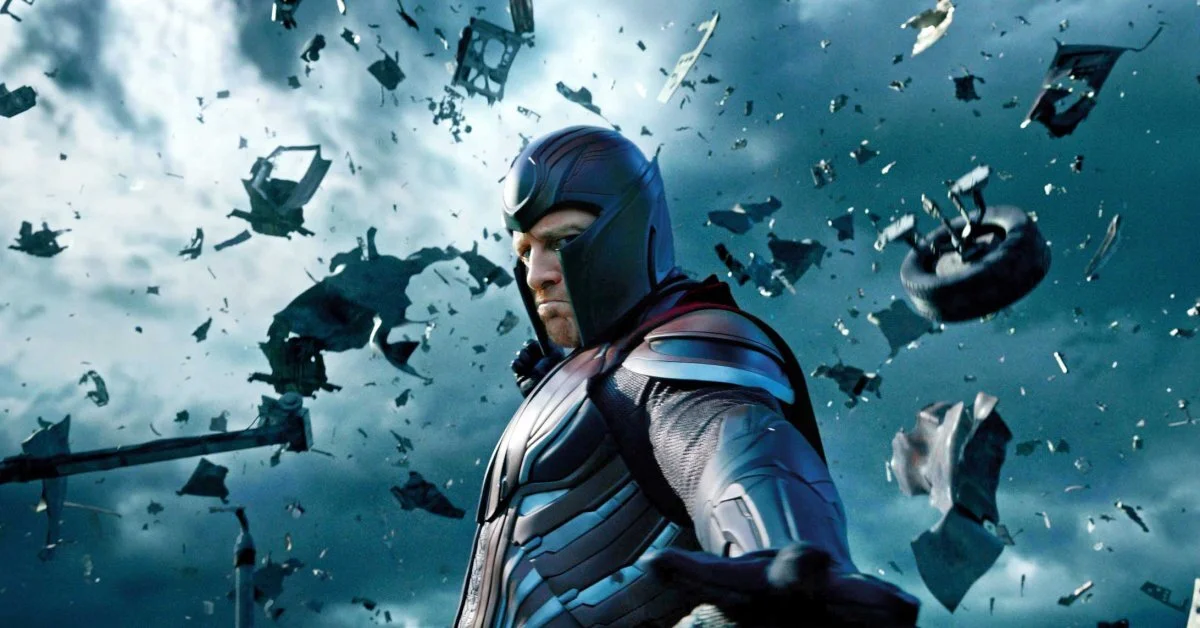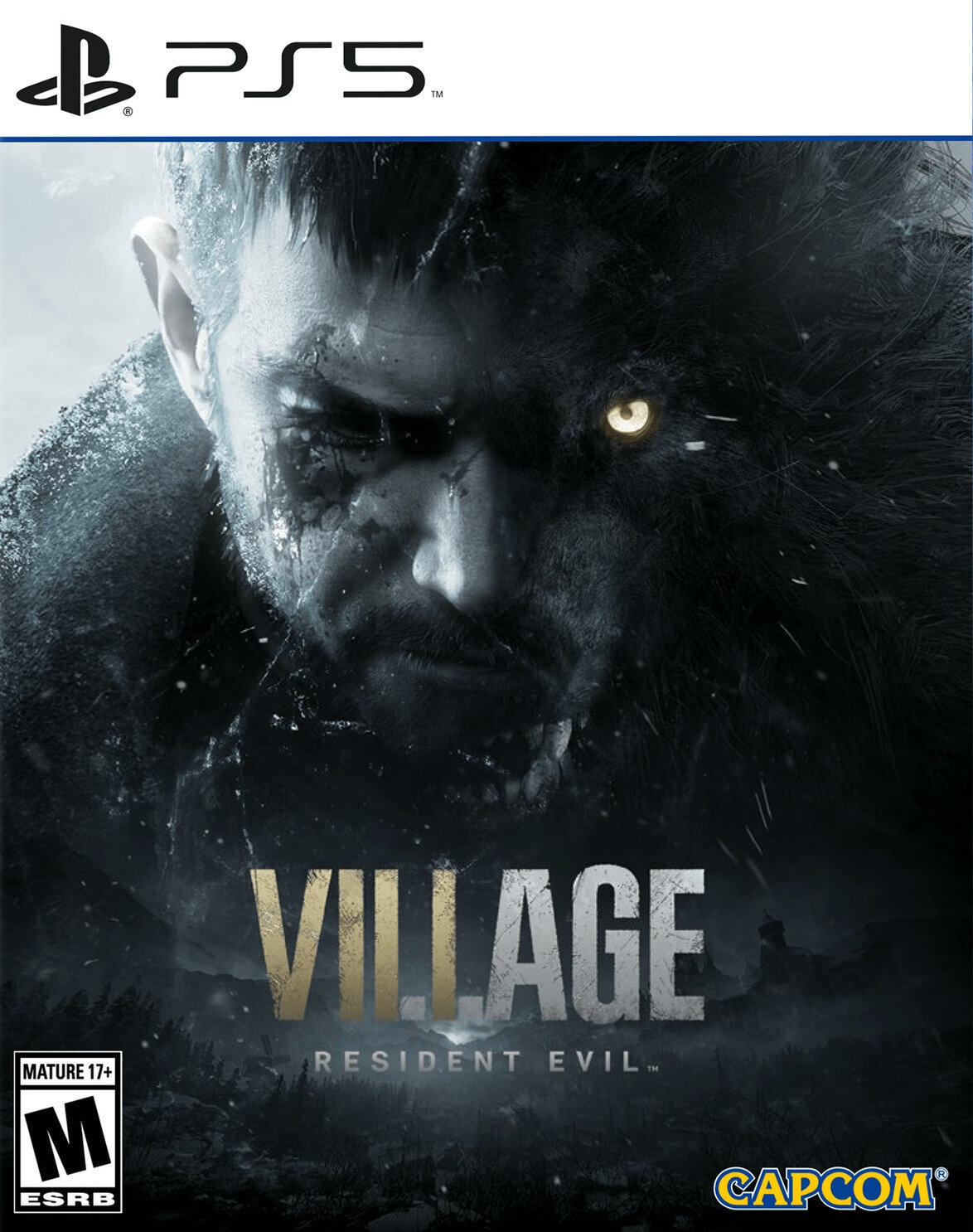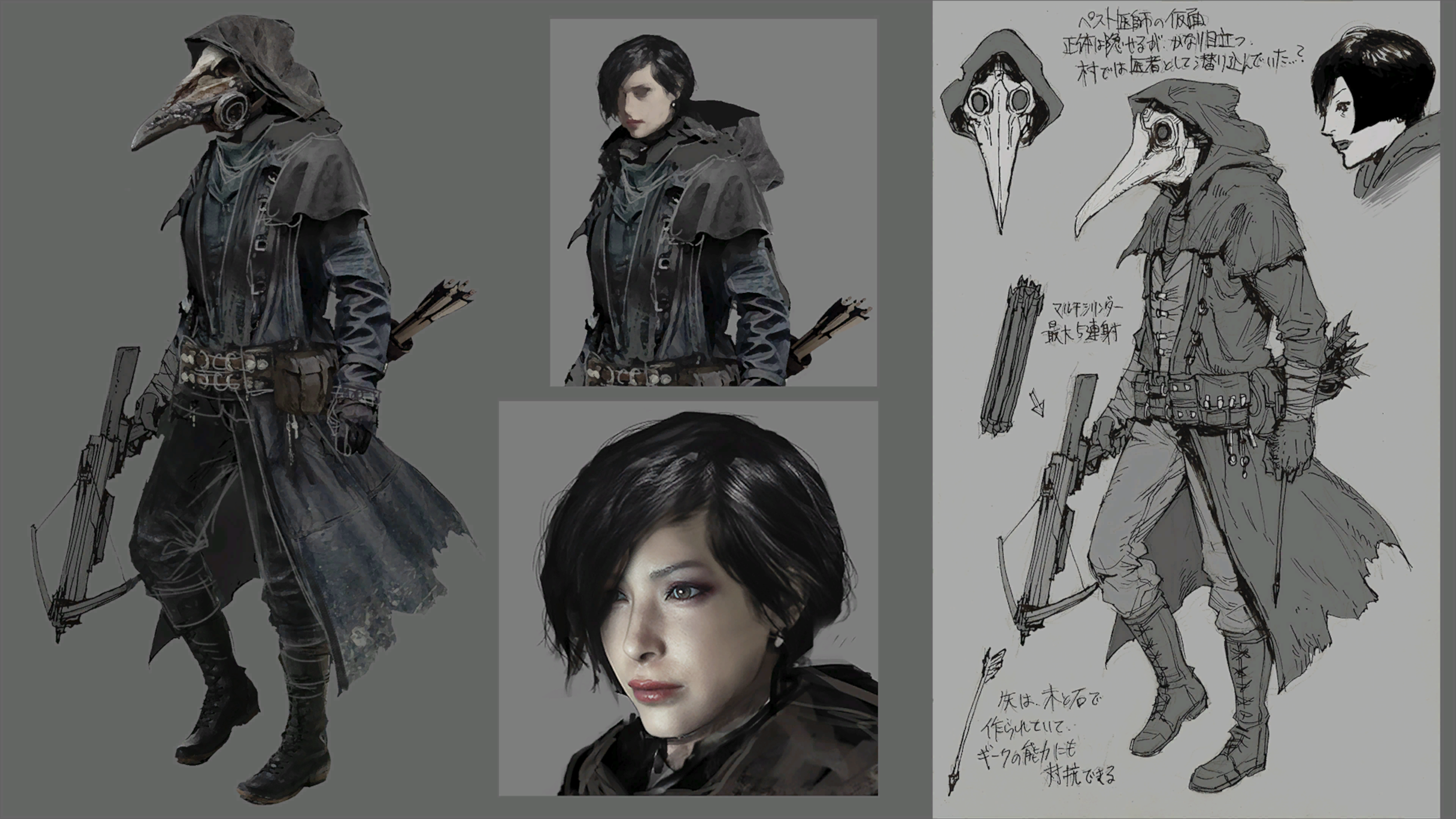Resident Evil Village
I didn’t expect to write this review.
For me, RESIDENT EVIL VILLAGE was supposed to be the video game equivalent of ordering comfort food from a fancy new restaurant: a novel, but safe, source of dopamine in these trying times.
And for a while, it was just that.
But by the end, it stirred up some shit, and now I can’t even think about it without reliving my entire tumultuous relationship with the Resident Evil series - the good times, and the bad breakups.
If you’re not a longtime fan of the series, don’t worry - VILLAGE’s strengths and shortcomings stand on their own. But I can’t leave this review at just a list of this one game’s pros and cons in isolation. I just gotta unpack all my baggage here. It’s staring me in the face each time I look at the box.
Heads-up: This review is going to contain way more spoilers than I usually include, specifically around the plot of the game…but, for what it’s worth, I also sincerely think this is one of those pieces of media that’s actually improved by knowing the spoilers ahead of time. The twists here are so goofy and so badly-handled that if you know them going into it, then you (hopefully) won’t be pulled out of the experience as much when they happen.
There’s also gonna be spoilers for RESIDENT EVIL 7 too - but for completely different reasons. That game’s great, and I wholly recommend it.
And now…on with the show.
A history of Resident Evil
New Resident Evil games have been released nearly every year since 1996. There are 10 entries in the “main series” (13 if you count the remakes separately), and even more side-games. The story has been continuing for 25 years now, without any reboots.
On the surface, it seems like there’s a lot of consistency, and the developer being the same for virtually every entry in the series might give you the impression of persistent authorial voice.
But this is the wrong way to look at these sorts of media franchises.
Capcom is a company, not an author, and individual video games (like movies and TV shows) are made by dozens-to-hundreds of people. Each person is a potentially unique source of creative input, shaped by different tastes and reacting differently to cultural trends.
On top of that, any media property with enough installments is going to end up with a full spread of ups and downs over its run. No matter how skilled the people involved are, there’s going to be variation in output - there’s just too many factors involved for there not to be.
So we really shouldn’t be thinking of these series like they’re the output of a consistent author that is gradually learning and iterating on the same thing, getting progressively and linearly better as time goes on.
We shouldn’t expect these series to work like that.
But to some degree we can’t help it.
Over the years, the story of Resident Evil isn’t just the canon of what happens to its characters - it’s also the progression of our reactions to the games. And whether or not it should, it still shapes our expectations going into these games. Capcom isn’t a single consistent author, but I am a single consistent consumer. A narrative inevitably forms, and it affects how I understand the games.
So here’s the story of Resident Evil that’s taken root in my head:
The original RESIDENT EVIL was one of the first successful 3D horror games, and led to the invention of the term “survival horror” - which basically got defined as “games that resembled RESIDENT EVIL”. (Another famous early survival horror series began with SILENT HILL, and that game was initially designed to be a RESIDENT EVIL clone.) These games focused on creating an air of tension through fixed camera angles and resource management. Because the player couldn’t control the camera, the developer knew with certainty what the player could see at any point in gameplay, and frame “shots” for mood or scares the same way you could in horror movies. Meanwhile, scarce resources and a tight limit on how many you could stockpile meant there were always more enemies than you had bullets - so the goal wasn’t to wipe them all out, but just to survive. Hence the genre name.
The first six main-series Resident Evil games followed these conventions, up to and including the remake of RESIDENT EVIL that came out in 2002.
Compositions like this one were common in these fixed-camera survival horror games - where the player character (top left) is framed as smaller than the zombie taking up most of the frame as it advances on her
Then the series reinvented itself with the release of RESIDENT EVIL 4 in 2005.
The camera was now mobile, following closely behind the player in an over-the-shoulder 3rd person perspective - which meant the player could control where the camera was looking, which moved the level design away from the claustrophobic corridors of previous entries and into more wide-open spaces throughout which the player could actively maneuver. Ammo was much more plentiful and you were be able to stockpile more of it. These design choices shifted the challenge of the game from “dealing with one or two enemies more than you have bullets for in a cramped hallway” to “managing large crowds in open spaces with a variety of tools as they try to surround you”.
The change to the basic structure of enemy encounters was echoed by a change in the enemies themselves. In the early Resident Evil games, enemies were threatening because it took a lot of resources to take down even one of them, and you were often stuck in tight spaces - which meant that slow-moving, virtually-unkillable zombies were a perfect fit. Although the series has always featured a variety of monsters, “Resident Evil” had long been synonymous with “zombies”. But in RESIDENT EVIL 4, the basic enemies are living people possessed by a semi-intelligent parasite, who can therefore communicate with each other, use weapons, flank you, etc. It may seem minor, but this change featured prominently in advertising for 4, and the game itself even calls attention to it as soon as you kill the first enemy, as if to say “This ain’t yo daddy’s Resident Evil!”
It’s actually pretty funny if you play this game without knowing that your protagonist used to fight zombies, and imagine that this is just his default reaction after murdering someone
This game also came out amid the rise of “fast zombies” in American and British media, largely propelled by the success of movies like 28 DAYS LATER (2002) and the remake of DAWN OF THE DEAD (2004), and echoed in books like THE ZOMBIE SURVIVAL GUIDE (2003) and WORLD WAR Z (2006). While I suspect that RESIDENT EVIL 4’s decision to move away from “slow zombies” had more to do with designing enemies that fit their new combat mechanics (and with trying to reinvent their brand) than with riding the “fast zombie” zeitgeist, it still ended up working out well for them. The early 2000s was a good time to be releasing media that “reinvented zombies”.
Giving players more mobility, as well as an arsenal with which to blow up increasingly huge crowds of enemies, moved the series past most traditional definitions of “survival horror”. These days, the term for RESIDENT EVIL 4 (and its various successors/clones, like DEAD SPACE) is “action horror”. And make no mistake, RESIDENT EVIL 4 went big on the action. You start the game in a creepy little village, but by the end you’re escaping an exploding military base on a jetski.
So, how’d it do?
RESIDENT EVIL 4 won basically every “Game of the Year” award ever, and ended up getting ported to new platforms and re-released even more times than SKYRIM - so it’s unsurprising that RESIDENT EVIL 5 went harder on everything that 4 did. Now, I’ve already complained at length about the sort of things they got up to in 5, so this time I’ll just leave you with the following illustration:
In both 4 and 5, there’s a battle against a giant early on in the game. In 4, you have to fight it with scant few weapons and ammo, a knife, and grit. In 5, the game gives you a humvee-mounted minigun that you fire directly into its face, point-blank, in a constant stream that it just stares at long enough for it to be truly funny.
Despite how over-the-top RESIDENT EVIL 5 was, it sold even better than 4, so the design philosophy for RESIDENT EVIL 6 was essentially just a Post-It note with the word “more” on it.
Here’s a sampling of what that looked like:
You fight a cyborg zombie hulk with a turret from the back of a helicopter as it hops across other helicopters and throws missiles at you. You fight an electric blob monster built to destroy the world in a secret lab at the bottom of the ocean. You use a thunderstorm to kill a giant insect made of zombies on top of a skyscraper, which previously used to be a T-rex made of body parts that hits you with cars.
And I’m not even touching on how bugshit bonkers the story is.
If RESIDENT EVIL 5 was over-the-top, then RESIDENT EVIL 6 was inventing whole new kinds of mutant sharks to jump over.
Like this one. (Which is supposed to be a mutant human that just happens to look like a shark, for no particular reason.)
So let’s recap the arc of Resident Evil’s action-horror reinvention thus far:
RESIDENT EVIL 4 was legitimately great, and took the series in a new direction in terms of genre and basic design.
RESIDENT EVIL 5 was the goofy obligatory sequel, and while I was overall disappointed by it, it was still a very fun game.
RESIDENT EVIL 6 was even goofier, even more disappointing, and it was a goddamn chore to play.
It has mandatory vehicle sequences that are easy to fail, forcing you to repeat them before you can get back to the core gameplay. It has bosses that just do not die over repeated encounters, making the constant battles with them feel pointless and tedious instead of exciting and intense. It has four distinct campaigns with intersecting plotlines, with some sequences repeated across different characters. All this added up to an estimated playtime of over 21 hours, which puts it in the same league as epic story-driven RPGs like MASS EFFECT - not action horror games, which tended to clock in at about ½ to ⅔ that length. Any fun to be found in the game is crushed under all the bloat.
So, how’d it do?
RESIDENT EVIL 6 still sold a lot - but it performed way under expectations, taking several years to achieve the sales numbers that Capcom projected it to hit in the first two months after launch (and that was after the success of 5 theoretically boosting its sales). With 6 being the most expensive Resident Evil game to develop thus far, the sluggish sales were a black eye that Capcom had to report to investors when explaining why money numbers go down that quarter. Critical reception, meanwhile, was mixed at best (Metacritic claims this was the first main-series Resident Evil game that didn’t get a positive reception from critics; I claim that the game sucked).
Then along came RESIDENT EVIL 7.
In a lot of ways, RESIDENT EVIL 7’s release was reminiscent of RESIDENT EVIL 4’s. Like RESIDENT EVIL 4, it changed the camera position away from one that was strongly identified with the series (this time, to a 1st-person perspective), which again had a major impact on the design on the game (more tight spaces, different combat dynamics). Like RESIDENT EVIL 4, it introduced a new type of monster that the story centered around (creatures created by a mutant mold). And like RESIDENT EVIL 4, it was released after the main-series Resident Evil games had been hitting the same note for a decade and it felt like it was time for something new.
But in a couple of ways, RESIDENT EVIL 7 felt like an even bigger break from what came before it than RESIDENT EVIL 4 did. For instance, it introduced a brand new protagonist - a random dude named Ethan Winters - who, for the first time, had absolutely no connection to any other character, organization, or event from prior in the series’ canon.
But the biggest shift was in genre.
RESIDENT EVIL 7 brought a renewed focus on capital-h Horror - announced loudly at the beginning of the game with moments of intimate bodily violence straight out of the HOSTEL movies. The game’s story ditches globe-trotting adventures and city-leveling zombie plagues, and is instead rooted in a small-scale “creepy family kills people” premise from horror flicks like THE HILLS HAVE EYES or THE TEXAS CHAINSAW MASSACRE, with some more modern influences mixed in (there’s some found-footage-horror with the crew of a Ghost Hunters-style show that recreates one of the most famous shots from THE BLAIR WITCH PROJECT, and then later a whole section that lifts heavily from both real-world escape rooms and the SAW franchise, just to give you an idea). Instead of things as overblown as dinosaur-sized monsters throwing cars at you, you had a creepy skinny dude looking right at you as he smiles and pulls his own fingernail out. That’s how RESIDENT EVIL 7 rolls.
One of the most memorable scenes in RESIDENT EVIL 7 takes place at a messy dinner table - and I struggle to think of any other scene from earlier in the series that’s this intimate
It was really, really hard not to see RESIDENT EVIL 7 as a response to RESIDENT EVIL 6.
Back in 2012, you had RESIDENT EVIL 6 staff giving interviews about struggling to make Resident Evil more mainstream to draw in more types of players, about how worried they were about losing sales if they focused too much on horror, about how “we're making games and we need to have mass-market appeal in order to survive” (archived).
And then in 2017, RESIDENT EVIL 7 came out wearing its horror-movie inspirations so proudly that the first expansion for the game was called “Banned Footage”. The critical response was overwhelmingly positive, too, with many reviewers listing it among the best games of the year. I loved it.
Counter-intuitively, all the changes that RESIDENT EVIL 7 introduced created an impression that the series was “going back to its roots” - a sense which only deepened in the following years.
In 2019, Capcom released a remake of RESIDENT EVIL 2, one of the more popular titles from back in the survival horror days of the series. The remake had the same basic camera and control scheme as the action horror entries like RESIDENT EVIL 4, but focused more on the survival elements like the original. We were back to navigating claustrophobic hallways with zombies that refused to die and not enough bullets. The remade RESIDENT EVIL 2 was a commercial and critical success, and reviews of the game were full of nostalgic praise for the “heyday of survival horror games”.
In 2020, they released a remake of RESIDENT EVIL 3, another popular title from the survival horror era. It did fine, but the bigger news came a couple months later, when they announced the sequel to RESIDENT EVIL 7 - which would continue the story of newcomer Ethan Winters, and was to be set in an isolated European village with a weird local religion, huddled in the shadow of a creepy castle with a sinister history. The game was initially titled “Resident Evil 8”, with the Roman numeral “VIII” cleverly overlaid onto the word “village” - until it was revealed that the official title was actually going to be RESIDENT EVIL VILLAGE.
And if you’re wondering why a village featured so prominently in the branding for the game, remember that “an isolated European village with a weird local religion, huddled in the shadow of a creepy castle with a sinister history” is the exact same setting that RESIDENT EVIL 4 started off with. Capcom really wanted you to think of this game as a combination of RESIDENT EVIL 4 and RESIDENT EVIL 7, which happen to be two of the best-received games in the series. (They probably also didn’t mind the visual comparisons to BLOODBORNE, one of the most successful games of the previous console generation.)
So, after all this…
Can you blame me for thinking the bad times were over?
That “Capcom had learned its lesson” - even though that’s not how large game development studios or long-running media properties work?
I hated RESIDENT EVIL 6 so much that I swore off the series after it - only to break that promise immediately, after I played a demo for RESIDENT EVIL 7 that made it clear it had almost nothing in common with 6. It was so easy to think that the series had found its way again. Everything that came after it only deepened that feeling.
Again, can you blame me?
I do, though - in hindsight.
There was one thing that really sucked about RESIDENT EVIL 7: the last five minutes.
In the finale, you confront the source of all the game’s misery - a scared, confused little girl with horrible powers, trapped in a rapidly aging body. Despite all her cruelty, she was ultimately just a child who didn’t understand the world or her actions. In a cutscene, you administer a fatal drug, and her final moments are gut-wrenching. It’s a surprisingly poignant and tragic moment for the series, and it really lands.
But then for the next five minutes she turns into a giant angry-faced tentacle monster bigger than a house that curses at you like a generic video game villain, until someone gives you a super-gun to kill her with.
And the person who shows up to give you the super gun is then revealed to be Chris Redfield - one of the heroes from the original RESIDENT EVIL, and one of the recurring characters who is most emblematic of the goofier excesses of the series - particularly after a moment in the finale of RESIDENT EVIL 5 where he punches a boulder in a volcano.
RESIDENT EVIL 5, again (source)
You can imagine why I wasn’t thrilled to see ChadBro McBoulderBoxer show up at the very end of my delightful little horror movie of a game. As a friend who had played both 5 and 7 with me put it: “They took a great ending, and then just Resident Evil’d all over it.” At the time, I had a sinking feeling about what it meant for the next games in the series. But that feeling faded as I enjoyed the remake of RESIDENT EVIL 2, and the trailers for VILLAGE. And besides, it was literally just a couple minutes at the very end - the whole rest of RESIDENT EVIL 7 was awesome.
It turns out that feeling was dead right, though.
VILLAGE kinda has the same problem as 7 (and a couple of new ones). Except this time, it’s not the last 5 minutes that suck - it’s the last couple of hours. And in its final moments, it again sets up elements of a sequel that look even worse.
It’s a pity, because the beginning of the game is great.
Tooth and Nail,
Nickel and Dime
Once you arrive in the eponymous village, the game’s atmosphere is wonderful. The game takes its time with the mood, letting you wander through the vacant wreckage of small homes and stables, finding warm food still on stoves to hint at the recency of whatever tragedy just transpired (and therefore the nearness of danger). The amount of personality and detail in the detritus is more impressive and engrossing than all the bright and crowded visuals of RESIDENT EVIL 6 combined, and it’s easy to sink into that atmosphere and feel nervous as you explore - even if you’ve played enough of these games to tell when there’s not going to be any actual danger.
The very first enemy you encounter is loud, bestial, and agile. It gorily bites off two of your fingers in its introductory cutscene, and takes nearly all of your starting ammo to take down (on most difficulty settings, at least). Things are immediately tense and desperate.
Combat in VILLAGE has been tweaked somewhat from RESIDENT EVIL 7, and mostly in ways that emphasize the feeling of being overwhelmed. Basic enemies move faster, dodge more often, and have more health than they did in 7. When one of their attacks hits you, it doesn’t just deal some damage and elicit an “I got hit!” grunt from Ethan - instead, they grab you, swing the camera to bring your gaze directly into their hateful faces, and make you watch as they sink their jagged teeth or rusty pickaxe into you. Every time they hit you.
These micro-cutscenes on each attack make every enemy seem overpowering, while also cleverly solving a problem of first-person combat (being hit by something you’re not looking at, and therefore not knowing what happened) in a way that seamlessly blends into the game’s aesthetics. It can get pretty tedious if you get hit a lot, but that’s part of this game’s way of encouraging you to use the “block” mechanic more (along with the fact that now, if you successfully block an attack, you are sometimes prompted for a bonus counterattack - another improvement on 7’s mechanics). Blocking makes Ethan raise his arms up in a “please don’t hurt me” pose - which also holds the hand missing two fingers right in front of the camera, a constant reminder of that initial encounter - so even when you’re successfully avoiding damage, you’re still made to feel overwhelmed.
It isn’t just non-stop doom-and-gloom, though. The most important feature that VILLAGE lifts from RESIDENT EVIL 4 is also what gives the player the strongest feelings of empowerment and safety periodically throughout the game: the merchant.
In both games, this is a reappearing character who lets you spend currency to upgrade your arsenal by purchasing stronger weapons or augmenting their stats. In VILLAGE, this character is named “the Duke”, (and in a bit of idle dialog, he makes a joke suggesting he was actually friends with the nameless merchant from RESIDENT EVIL 4, which opens up some questions about the continuity between these games that I’m not even gonna go into here - I’ve got much more ridiculous fish to fry). The Duke is even more helpful than his predecessor, because you can also buy ammo from him - providing a potential relief for players struggling under the ammo scarcity that is central to how the game manages a feeling of tension as you play. Both in VILLAGE and in 4, the currency you spend comes from killing enemies (mainly bosses), and from finding hidden treasures (that often add flavor to the setting).
The merchant characters do a lot of work in these games.
By regularly giving you safe spaces where you can upgrade your gear, the game is giving you a way to achieve a feeling of control. By hiding optional treasures throughout the map, the game gives you an additional, aspirational goal beyond just survival: if you find enough loot and invest it wisely, you can hope to outpace the difficulty curve. There’s also a comfort that comes with predictability,: you know there’s going to be a safe room with the Duke and his bag of goodies every so often. (Unsurprisingly, the creepiest area of the game is also the one that the Duke doesn’t appear in.) Resident Evil games have always had safe rooms, but they haven’t always had regular access to character progression. That’s the sort of thing that shifts the player’s goals from “I hope I can survive what the game throws at me next” to “I can’t wait to upgrade my best gun so I can clown on the next boss”. The merchant is the bridge from survival horror to action horror - that’s why you don’t meet one in VILLAGE until after the most dire opening segments when the game wants you to feel the most desperate.
Once you meet the Duke, the game properly begins - and the next segments of the game continue to be awesome.
Bowsette Dracula
RESIDENT EVIL VILLAGE has a pretty standard antagonist ladder, as far as these games go. There’s a Big Bad that serves as the final boss, and you have to fight through each of their lieutenants to get to them - with each one presiding over their own section of the game, with its own challenges and motifs.
In this game, there are four such lieutenants, and each one is is both inspired by and evocative of a classic Hollywood movie monster: an aristocratic vampire in an ancient castle, a ghostly figure animating creepy dolls, a fish-man that lives in a lake, and a mad tinkerer who stitches together corpses and uses electricity to bring them back to life.
The first of these also happens to be easily the best character in the game: Lady Dimitrescu.
As soon as she debuted in trailers for the game she became a certified Internet Sensation™, and in case you missed it, lemme tell you - the thirst was real. And like with other certified Internet Sensations™, we then got waves of articles pretending to puzzle out her appeal - just like we did when fans speculated that an item from a new Mario game would turn Bowser into a busty anime babe, and the BuzzFeedosphere acted perplexed about the seemingly inexplicable allure of “what if recognizable pop culture property, but also giant tits”.
So in case you were wondering, lemme walk you through the math here: Lady Dimitrescu is a conventionally-attractive woman, with a design that is both simple and distinctive - making it easy to successfully recreate her in fan art and cosplay.
But don’t get me twisted - this is a great design.
The character was always intended to be an aristocratic vampire, but art director Tomonori Takano had the idea to mix in some of Hachishaku-sama (an unnaturally tall woman in Japanese urban legends), and made Dimitrescu tower over the player at just over 9 feet tall. According to Takano, the moment he drew a concept sketch of the oversized patrician bending over to fit through a normal-sized doorway, he knew he’d struck gold.
Scaling Lady Dimitrescu up makes her an imposing villain in both obvious and subtle ways (like the way it gives her upper-class condescension some newly predatory undertones as she towers over you, directly invoking the well-worn theme of vampires-as-metaphor-for-aristocracy). Her stature also magnifies an awesome performance, both by the visual artists who hand-sculpted Dimitrescu’s facial features during her cutscenes (leading to a more seamless matching of visuals to vocals than other characters get during normal gameplay) and by the voice artist who just knocks it out of the park. For an otherwise typical one-note Resident Evil villain, she just oozes charisma.
Lady Dimitrescu’s castle is also one of the settings that the Resident Evil series has always done well: a sprawling, cavernous building whose interiors alternate between sinisterly ornate and overtly horrific, and whose dark histories you find through scraps and notes that tell you what happened to the lost souls who came here before you.
Spooky-lore-via-memos is vintage Resident Evil stuff - along with settings that are prettier than they have any right to be. In the earlier games, the fixed camera angles meant the game didn’t need to actually model every object in the room (since it could only ever be seen and lit one way), so the environments could basically just be flat images - which could be much more intricate and detailed than what contemporary hardware could render as 3D objects, leading to painterly backdrops that often looked way better than games of their time should. Visually rich settings have quietly been an integral part of the Resident Evil brand over the decades. It’s why the series loves to put you in mansions and castles (and turns other settings, like police stations, into mansions), and it’s what inspires fan mods that amount to art restoration. Castle Dimitrescu and its intimidatingly gorgeous master fit right in.
The boss fight against Lady D is a little overblown, but serviceable. Taking her down is your first major culmination in the game, and you come out of it feeling like a badass - which makes it a great time to swing back in the other direction.
The next segment, where you take down the second lieutenant in the game’s boss ladder, is pure horror. It’s a little brisk, and light on lore/worldbuilding, but it’s got the best creep factor in the game by a huge margin, and has some wonderfully inventive moments. If this part of the game hasn’t been spoiled for you by now, then I’m not gonna be the one to do it. Play and enjoy.
Unfortunately, after this point VILLAGE goes downhill real fast.
Dr. Magneto Frankenstein
The following segment is forgettable at best. The gameplay, enemy encounters, and setting are all muted and generic (it’s a couple of waterlogged fishing shacks and the world’s smallest lake). What really makes this part feel phoned-in is the boss, though - the fish-man.
The scene begins with the guy dropping into water, and turning into a whale-sized monster off-camera in just a couple seconds. (Resident Evil loves to have people turn into giant monsters, but this is probably the laziest execution yet.) Before the battle proper, he spends some time menacing you from underwater, which involves him visibly swimming through physical structures like there’s no collision detection underwater and obviously teleporting from one part of the lake to another as he follows you. I don’t think I’ve played a segment in any Resident Evil game that felt more like it was just going through the motions; by the end I was wondering why the developers even included it at all.
What’s next is a little interlude where the game throws an unreasonable amount of basic enemies at you in a pretty obvious attempt to drain your healing/ammo resources to re-establish a feeling of tension similar to the game’s opening areas. This time around, though, it feels less tense and more like a chore. And slogging through a truckload of the first enemy type you encountered isn’t exactly a stirring recovery from the doldrums of the previous segment. All in all, the middle is a surprisingly boring stretch of VILLAGE.
But fear not, because here is when the game starts to get well and truly dumb.
Lemme introduce you to Karl Heisenberg.
Heisenberg is RESIDENT EVIL VILLAGE’s stand-in for Dr. Frankenstein in its roster of callbacks to horror movie monsters, and our final stop on the boss ladder before the Big Bad. In the game’s story, he’s been spending his time collecting corpses from the village and using weird science to bring them back to life (seems a little pedestrian for an end-game villain from a late entry in a series famous for zombies, but hey). Concept art and design notes that are included with the game itself reaffirm this, showing sketches of him having reanimated his dead mother, and ordering minions to dig up corpses for his experiments.
But he’s got another gimmick.
He can control anything metal with his mind.
As in, he can make anything from a knife to a sheet of steel whiz through the air at whatever speed he wants, with perfect precision.
This is a character you have to beat, in a video game where your hero’s only power is “has a gun”.
Hey, for no reason, here’s a totally random scene of Magneto from 2000’s X-MEN.
Not only is this part of Heisenberg’s concept distractingly out-of-genre for the series as a whole, his entire segment is aesthetically out-of-place in this particular game. In his factory, he mass-produces cyborg Frankensteins with drills for arms, jets on their back, and airplane propellers where the blades are chainsaws strapped to their torsos.
Would you have guessed this is in the same game as the earlier screenshots in this article?
Even the scale of this section feels wrong. Each time I get to this part, I find myself staring at this endless assembly line of Frankenbots and wondering, “Were there even that many people in this entire village?”
All this stuff could be fine in a vacuum. I mean, I get what they were going for. The new robot enemies are pretty clear callbacks to the Regenerators from RESIDENT EVIL 4: late-game enemies in a novel environment that have a gimmick which makes them harder to kill than other enemies. And as ridiculous as these metal-infused zombies are, it’s not categorically bad design - they’d fit in just fine in a game like THE EVIL WITHIN, or even a different Resident Evil game, like RESIDENT EVIL: REVELATIONS 2.
But I don’t understand what this stuff is doing in this game.
And it doesn’t seem like the game’s creators know, either - that sense of not-even-trying that we saw in the fish-man’s boss fight is here in full force. Dialog and character behavior get flimsier (the section begins with Ethan leaving the MacGuffin behind for essentially no reason), and the flow of lore via memos - which had already been reduced to a trickle after Castle Dimitrescu - finally dries up. (Earlier in development, there were plans to give Hesienberg more texture and story, including revealing that one of the meat-and-metal monsters in the level was originally his father, but none of that made it into the final game.) If this segment were full of crowds of monsters, like its analog in RESIDENT EVIL 4 (the military base), I could understand ditching the worldbuilding to focus on action - but combat is a little sparse here and there’s tons of backtracking, so the whole area just ends up feeling pretty empty. Why is this here?
Then, just before it’s time to go fight Magneto with your metal gun that fires metal bullets, the game tells you that he had built a tank out of some sort of “metal/polymer composite, which he can’t control” (and I guess it has no metal anywhere in its wiring, or in the ammunition it fires), for some reason, and that’s what you’re going to use to fight him.
Not that it matters, though, because instead of using his powers to throw sharp bits of metal at you like he does in all his previous cutscenes, he instead turns himself into a big visually confusing mess that looks like it belongs in TRANSFORMERS, so that he can have a fistfight with your tank. Which has a rocket launcher, and blocks his attacks with a chainsaw arm.
There’s also two moments in the fight where he uses his powers to levitate the tank that was specifically introduced as something that Heisenberg shouldn’t be able to control with his powers.
Each choice is bewildering. It’s a comedy of unforced errors: If you wanted us to fight a giant flesh-and-metal monster (as indicated by early concept art), why did you also make the monster into Magneto? If you wanted to give us a novel weapon that Magneto can’t stop, why did you decide that Magneto himself made it? If you wanted us to use a tank that Magneto can’t mess with, why did you have him levitate it multiple times in the boss fight anyway? And why do any of this in RESIDENT EVIL VILLAGE?
That’s not even the best part:
It’s in this boss fight where the game decides to make a joke about the series’ previous excesses, by having Heisenberg call Chris Redfield a “boulder-punching asshole”.
I hope you’re strapped in, because now I’m gonna talk about the actual worst part of this game.
The Ballad of
ChadBro McBoulderBoxer
Those of you who have actually played RESIDENT EVIL VILLAGE probably noticed that I skipped over something from the beginning of the game.
Before you get to the village, the game begins with Ethan’s wife, Mia, reading a dark fairy tale to your infant daughter. After that, longtime series hero Chris Redfield breaks into your home, shoots your wife in the goddamn head right in front of you, and kidnaps your baby.
This is meant to be a jarring hook: “Oh no, Chris Redfield has suddenly turned cartoonishly evil!” Except if you’ve seen at least five or six pieces of media total in your life, you probably realize that’s not what’s going on. When you see an episode of Superman that begins with him killing Lois Lane, you don’t think “Oh no, I guess Superman’s evil now!”; you know something’s up.
Well, right before the fight with Heisenberg, Chris shows up and explains everything to you.
It turns out that it wasn’t your wife he shot, but the Big Bad of this game - Mother Miranda - who has the ability to perfectly mimic anyone else at will, and was pretending to be your wife so that she could kidnap your daughter…later, I guess. Chris showed up to kill Miranda, and then kidnapped your baby to “protect” it, and instead of explaining any of this to you he just had his goons knock you out, because…well, that’s what it took to set up the game’s paper-thin “ChRiS eViL?!?!?” hook. Chris also reveals that Mother Miranda survived the assassination attempt and got away by using her powers to “mimic a corpse”, which is absolutely the funniest fucking way to say “she just played dead after I shot her in the goddamn head” I could ever imagine.
Anyway, after this Looney Tunes infodump, you kill Heisenberg, then Mother Miranda shows up, repeats the information from Chris’ infodump, and rips out your heart and kills you.
And now you play as Chris.
Seriously.
After your death scene, the game cuts to Chris sitting in a car, looking at photos of events from the game you are fucking playing, as he narrates the plot that he and Mother Miranda literally just explained to you, followed by a retelling of what you just watched happen a minute ago, as though this were a particularly boring “Last time, on Resident Evil”-style intro to the sequel to the game that you are, again, currently playing.
The Chris segment then proceeds to introduce you, by name, to each of half-a-dozen commandos who all work for Chris in the “houndwolf squad” - who are all brand new characters, half of whose names are just synonyms for “wolf” (Chris’ nickname for himself is “Alpha”, which reads as kinda pathetic at a time when someone calling themselves “Alpha” evokes images of Jordan Peterson fanboys yelling “cuck!” at people on Twitter).
Official concept art and early storyboards for RESIDENT EVIL VILLAGE reveal that these characters were initially even more developed - to the point of being introduced in an action-movie-style-montage complete with title cards. Which is a weird thing to do for a handful of irrelevant side-characters in the final hour or two of your game, but hey
Having the player switch characters like this is jarring, but it’s not as much of a surprise as you might think, since the exact same thing happens in RESIDENT EVIL 7.
That game also has a moment where Ethan appears to die, and you then spend a while playing as someone else. That time, you play as Mia - who has unique insights into the backstory of the game, which you end up reliving during gameplay, keeping that segment narratively propulsive. Meanwhile, because you’re now playing as Mia, you don’t have access to all the weapons and ammo you had previously stockpiled as Ethan. Mia has just enough of an arsenal to not feel like you’re starting from scratch, but not enough to feel comfortable - allowing the game to effectively reset its tension and difficulty for a while, and keep you from just coasting through the final act on all your accumulated resources.
By contrast, in VILLAGE, the part where you play as Chris tells you virtually nothing that you didn’t already hear, from Chris, while you were controlling Ethan. You also lose access to all the weapons you stockpiled as Ethan, but all of Chris’s weapons are way better and he has virtually unlimited ammo, so instead of resetting the tension it removes it entirely. Someone suggested to me that this was done to let the player indulge in a power fantasy that is normally unavailable in survival horror games, but that doesn’t make sense here. First off, this isn’t a survival horror game. Second, and more importantly, the player just blew up Megatron using a tank, right before this. Power fantasy isn’t what they’re lacking.
The second half of RESIDENT EVIL VILLAGE doesn’t feel like the product of the resources and momentum won by four years of successful releases. It feels surprisingly half-assed and rushed.
This may be partly due to the fact that development of this game began in 2016, six months before the release of RESIDENT EVIL 7 - so while the praise earned by that game showed up partway into the development of VILLAGE, it didn’t inform the project at its outset. And while 7 didn’t underperform relative to Capcom’s projections, it’s still behind 4, 5, and 6 in lifetime sales (with 5 still leading that pack). So maybe it shouldn’t be that surprising to see VILLAGE’s producer talking about how they weren’t looking to replicate the success of 7, but instead “find a variation that works for a wider audience” (echoing the sentiments we heard from the leads of RESIDENT EVIL 6), in interviews just before VILLAGE’s release.
We also know that development of VILLAGE was impacted by the covid-19 pandemic, with Capcom staff confirming that production was halted for at least a month during the height of the 2020 lockdowns in Japan. It’s tempting to assume this explains why the latter portion of the game feels rushed, but it’s hard to find concrete info supporting that. An official video put out by Capcom seems to suggest that most of the pandemic’s impact amounted to reduced time to iterate on the appropriate difficulty for combat in the game - but since these videos are essentially just marketing, it’s hard to read too much into them.
On the unofficial side, a somewhat well-trafficked Resident Evil rumormonger named AestheticGamer claimed that VILLAGE got “scrapped and rebooted” and changed directors during its development - claims that I haven’t been able to find any confirmation for. AestheticGamer also said that VILLAGE would be “years away” in 2020, among other claims for this game that didn’t end up panning out - but whether that’s because their intel wasn’t legit, or just because their predictions based on it were wrong, is anyone’s guess. You can check out their bonafides and decide how much stock you wanna put in their claims.
But, as much as it’s fun and cathartic to look for some isolated externality that explains why a thing you wanted to love turned sour (and I’ll admit, Matt McMuscle’s “Wha Happun?” series has become a guilty pleasure of mine), the story is probably simpler than that: Some competent professionals just made some kinda crummy media this time around. Like I said before, there’s naturally going to be variation in the quality and consistency of the artistic output of a large, diverse team of creatives over time. And as much as my fondness for the recent products in the Resident Evil brand makes me crave a more specific explanation - and as much as we all live in a society where investors will demand an explanation every time money number go down - sometimes you just don’t get a complete and satisfying story for why it rained today when it was sunny yesterday.
It happens.
So anyway: at the end of Chris’ mediocre CALL OF DUTY impression, the game dumps you into a room full of memos that inelegantly provide all the lore and plot that was missing during the middle portion of the game, including finally telling you who Mother Miranda is and what her underlying motivations are. These memos also provide a whopping two paragraphs of backstory for each of Miranda’s four lieutenants - which is completely redundant for the two well-developed characters (Dimitrescu and Heisenberg), and completely insufficient for the two underdeveloped ones.
One of them does mention that Heisenberg’s comic-book-level superpowers come from “electric organs” similar to the Japanese sleeper ray, though, which is very funny.
Magneto, in the film X-MEN: APOCALYPSE, levitating a whole scrapyard of metal - which is exactly how Narke japonica, the Japanese sleeper ray, hunts small marine invertebrates on the sea floor near the Izu peninsula
Another memo in this room also establishes that Mother Miranda was actually penpals with Oswell Spencer, the guy behind the events of the first RESIDENT EVIL. This doesn’t really add anything to the universe of these games, and it doesn’t matter at all - Spencer is long dead, and Miranda is about to be - but, y’know. It’s there. (Are you feeling serviced, fans?)
And then Chris finds the real Mia, and she sets up the most Laffy Taffy plot twist of the game: Ethan didn’t get killed by Mother Miranda just now, because he’s actually been dead this whole time. The game then explains this in the worst-handled exposition I’ve seen in a long, long time - so I’m gonna take a sec to walk you through it:
We cut to a featureless snowy limbo, where we (as Ethan again) have to walk forward for a few steps before the game immediately disables our controls again. The little girl from the end of RESIDENT EVIL 7 appears, just far enough away to be out of focus so they don’t need a detailed in-game model for her, and reveals that Ethan actually died within the first hour of that game, and has actually been an unkillable self-regenerating mold monster ever since. (No explanation is given for how or why that transformation happened. Additionally, the whole plot of RESIDENT EVIL 7 was that this little girl turns people into mold monsters so that she can control them, so why she wouldn’t be able to control mold-monster-Ethan is kind of an important question.)
This takes minutes, as Ethan’s dialog is drawn out by cold-induced shivering. The most visually interesting thing that happens is that Ethan/the camera sometimes turns to face his hands, or the featureless ground, as the voice actor tries his best to find something interesting to do with his lines. This scene would be unacceptable in a movie or TV show; when you’re watching it with a controller in your hands, it’s even worse.
Technically, every cutscene in the game is structured this way - with something happening directly in front of the camera as Ethan reacts - but compare this sequence to the encounter with Lady Dimitrescu and her daughters. Look how that (much shorter) scene changes camera angles several times, how much attention and detail is given to the characters as each of them vamps for the camera in a different way befitting their personality, how much more dialog there is and how much better it flows. There were clearly people working on this game who knew what they were doing - so I couldn’t tell you how the most narratively significant cutscene in this AAA game ended up composed to look like a boring student film trying to hide its small budget.
Anyway, this twist is explained to be the reason why everyone cares so much about your infant daughter (I guess she’s part mold monster), and why you are able to recover from ridiculous injuries like Miranda ripping out your heart. Just like Heisenberg and his not-metal tank, this is a stupid solution to a problem they didn’t need to create for themselves to begin with.
This twist doesn’t explain why you weren’t able to regenerate the two fingers you lost at the beginning of this game, though.
I can see how that sort of thing would get missed - after all, you’re only reminded of those missing fingers every single time you climb a ladder or press the “block” button.
…look, I don’t want to give a shit about these sorts of things. I want to have fun getting spooked and fighting monsters. But when a game’s story retcons the twist from THE SIXTH SENSE into the previous game, this is the effect it’s going to have. When you start making narrative leaps this wild, they’re going to cause some confusion, and that confusion is going to lead the audience to start parsing your media more analytically while they’re still in the process of consuming it, just because they’re trying to regain a foothold and figure out where the boundaries of verisimilitude are anymore.
But the cinematic portions are executed so amateurishly that they can’t draw you into the story or characters. And there is no engaging gameplay to make a net to catch you anymore. Even if you wanted to come up with a more generous take on the second half of this game, it doesn’t give you the material to construct one.
In interviews and concept art notes, the creators of RESIDENT EVIL VILLAGE claim that they wanted to “continue the story” of Ethan Winters from RESIDENT EVIL 7. The collector’s edition of VILLAGE comes with an art book called “The Tragedy of Ethan Winters” that contains concept art and design notes for both 7 and VILLAGE. But VILLAGE isn’t Ethan’s story. At most, it’s a story of things that happen to him - he’s just running around, trying to avoid dying, while Chris Redfield does everything important.
It’s Chris Redfield that sets the events of the game in motion, and provides the hook for the game.
It’s Chris Redfield that figured out what Mother Miranda was up to, and tried to stop her.
It’s Chris Redfield that destroys Heisenberg’s factory of cyborg Frankensteins, and gives you a tank to take down Heisenberg himself.
It’s Chris Redfield that sets a bomb to destroy Mother Miranda and her village.
It’s Chris Redfield whose face is on the goddamn box for the game.
After the final boss fight, literally minutes after you’ve discovered that Ethan Winters is supposed to be functionally immortal (a weird thing to introduce before your final boss fight, by the way), Ethan then dies - for real this time - and it’s Chris Redfield who saves his child.
It’s Chris Redfield who the camera focuses on as he reacts to Ethan’s death in the final scenes.
It’s Chris Redfield who receives the setup for the next game in the the series (apparently some heroic organization from RESIDENT EVIL 5 has now gone evil).
The tragedy of Ethan Winters is that his life amounted to just another verse the ballad of Chris Redfield.
Or Ada Wong, another recurring character whose storyline over the series has contorted itself into a complete mess. (It’s a major focus in RESIDENT EVIL 6, and if I tried to explain it here this article would be another 3,000 words longer.)
She was originally going to be in this game, too
Or some other relative of former series antagonist Albert Wesker that they retcon into existence, like they did with Jake in RESIDENT EVIL 6 and Alex in RESIDENT EVIL: REVELATIONS 2.
Or whatever other dumb shit it’s taken me too long to admit is more core to Resident Evil than I’d like.
RESIDENT EVIL VILLAGE starts strong. Its first half is a showcase of the talent and passion of dozens, maybe hundreds, of creatives - delivering on things the series has been celebrated for, while making memorable additions to the canon.
But despite its strengths, it doesn’t end up as coherent and consistent as RESIDENT EVIL 7. VILLAGE is not the solid second step in an ascendant new vision for the series that I’d hoped for.
For all its faults, RESIDENT EVIL 5 was, at the very least, more of RESIDENT EVIL 4. It further committed to what 4 laid down.
While the first half of VILLAGE is more of RESIDENT EVIL 7, the second half is more of RESIDENT EVIL 5 and 6’s thoughtless escalation and immersion-ejecting narrative gibberish, all executed in a way that feels rushed and phoned-in at best. VILLAGE is stuck in the shadows of other Resident Evil games.
And it shows a developer so impatient to get to their next attempt to make mass-appeal horror-flavored action games that it aborted a pretty solid new game just to cut to an old series mascot, sitting in a darkened car summarizing what we just played, so he can introduce us to what he’s going to get up to in the next game.


